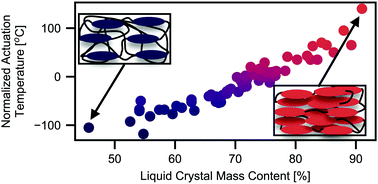Understanding the effect of liquid crystal content on the phase behavior and mechanical properties of liquid crystal elastomers†
Abstract
Liquid crystal elastomers are stimuli-responsive, shape-shifting materials. They typically require high temperatures for actuation which prohibits their use in many applications, such as biomedical devices. In this work, we demonstrate a simple and general approach to tune the order-to-disorder transition temperature (TODT) or nematic-to-isotropic transition temperature (TNI) of LCEs through variation of the overall liquid crystal mass content. We demonstrate reduction of the TNI in nematic LCEs through the incorporation of non-mesogenic linkers or the addition of lithium salts, and show that the TNI varies linearly with liquid crystal mass content over a broad range, approximately 50 °C. We also analyze data from prior reports that include three different mesogens, different network linking chemistries, and different alignment strategies, and show that the linear trend in TODT with liquid crystal mass content also holds for these systems. Finally, we demonstrate a simple approach to quantifying the maximum actuation strain through measurement of the soft elastic plateau and demonstrate applications of nematic LCEs with low TODTs, including the first body-responsive LCE that curls around a human finger due to body heat, and a fluidic channel that directionally pumps liquid when heated.



 Please wait while we load your content...
Please wait while we load your content...